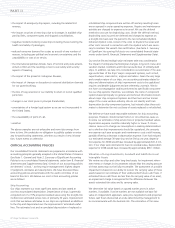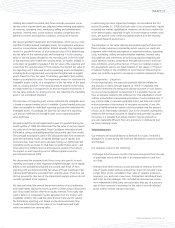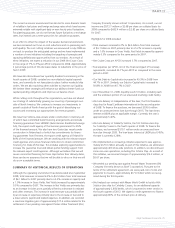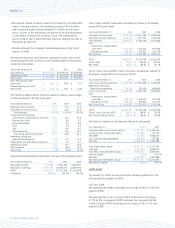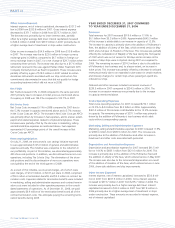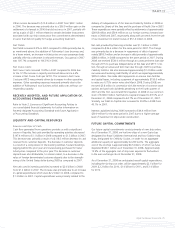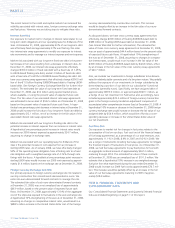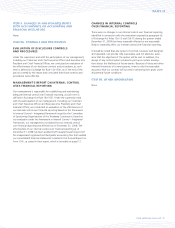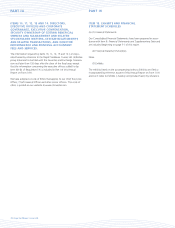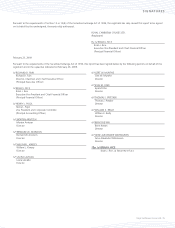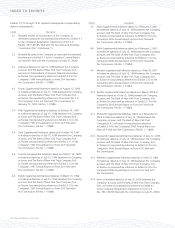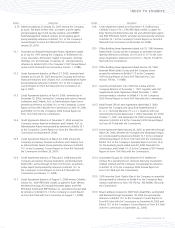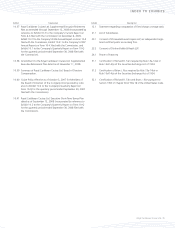Royal Caribbean Cruise Lines 2008 Annual Report Download - page 48
Download and view the complete annual report
Please find page 48 of the 2008 Royal Caribbean Cruise Lines annual report below. You can navigate through the pages in the report by either clicking on the pages listed below, or by using the keyword search tool below to find specific information within the annual report.
32 Royal Caribbean Cruises Ltd.
The recent turmoil in the credit and capital markets has increased the
volatility associated with interest rates, foreign currency exchange rates
and fuel prices. However, we are taking steps to mitigate these risks.
Interest Rate Risk
Our exposure to market risk for changes in interest rates relates to our
long-term debt obligations and our operating lease for Brilliance of the
Seas. At December 31, 2008, approximately 43% of our long-term debt
was effectively fixed and approximately 57% was floating. We enter
into interest rate swap agreements to modify our exposure to interest
rate movements and to manage our interest expense and rent expense.
Market risk associated with our long-term fixed rate debt is the poten-
tial increase in fair value resulting from a decrease in interest rates. At
December 31, 2008, our interest rate swap agreements effectively
changed $350.0 million of fixed rate debt with a fixed rate of 7.25%
to LIBOR-based floating rate debt, and E1.0 billion of fixed rate debt
with a fixed rate of 5.625% to EURIBOR-based floating rate debt. We
have cross currency swap agreements that effectively change E300.0 mil-
lion of the E1.0 billion floating EURIBOR-based debt to floating LIBOR-
based debt. (See Foreign Currency Exchange Rate Risk for further infor-
mation). The estimated fair value of our long-term fixed rate debt at
December 31, 2008, was $3.2 billion using quoted market prices,
where available, or using the present value of expected future cash
flows. The fair value of our associated interest rate swap agreements
was estimated to be an asset of $165.5 million as of December 31, 2008
based on the present value of expected future cash flows. A hypo-
thetical one percentage point decrease in interest rates at December 31,
2008 would increase the fair value of our long-term fixed rate debt by
approximately $12.1 million, net of an increase in the fair value of the
associated interest rate swap agreements.
Market risk associated with our long-term floating rate debt is the
potential increase in interest expense from an increase in interest rates.
A hypothetical one percentage point increase in interest rates would
increase our 2009 interest expense by approximately $24.7 million,
assuming no change in exchange rates.
Market risk associated with our operating lease for Brilliance of the
Seas is the potential increase in rent expense from an increase in
sterling LIBOR rates. As of January 2008, we have effectively changed
50% of the operating lease obligation from a floating rate to a fixed
rate obligation with a weighted-average rate of 4.76% through rate
fixings with the lessor. A hypothetical one percentage point increase in
sterling LIBOR rates would increase our 2009 rent expense by approxi-
mately $1.4 million, based on the exchange rate at December 31, 2008.
Foreign Currency Exchange Rate Risk
Our primary exposure to foreign currency exchange rate risk relates to
our ship construction firm commitments denominated in euros. We
enter into euro-denominated forward contracts to manage this risk.
The estimated fair value of such euro-denominated forward contracts
at December 31, 2008, was a net unrealized loss of approximately
$66.9 million, based on the present value of expected future cash
flows. At December 31, 2008, approximately 13.9% of the aggregate
cost of the ships was exposed to fluctuations in the euro exchange rate.
A hypothetical 10% strengthening of the euro as of December 31, 2008,
assuming no changes in comparative interest rates, would result in a
$588.5 million increase in the United States dollar cost of the foreign
currency denominated ship construction contracts. This increase
would be largely offset by an increase in the fair value of our euro-
denominated forward contracts.
As discussed above, we have cross currency swap agreements that
effectively change E300 million of floating EURIBOR-based debt to
$389 million of floating LIBOR-based debt at December 31, 2008.
(See Interest Rate Risk for further information). The estimated fair
value of these cross currency swap agreements at December 31, 2008,
was an asset of approximately $44.4 million based on the present value
of expected future cash flows. A hypothetical 10% strengthening of
the euro as of December 31, 2008, assuming no changes in compara-
tive interest rates, would result in an increase in the fair value of the
E300 million of floating EURIBOR-based debt by $42.8 million, offset
by an increase in the fair value of the cross currency swap agreements
of $43.7 million.
Also, we consider our investments in foreign subsidiaries to be denomi-
nated in relatively stable currencies and of a long-term nature. We partially
address the exposure of our investments in foreign subsidiaries by
denominating a portion of our debt in our subsidiaries’ functional
currencies (generally euros). Specifically, we have assigned debt of
approximately E393.0 million, or approximately $549.1 million, as
a hedge of our net investment in Pullmantur and, accordingly, have
included approximately $23.2 million of foreign-currency transaction
gains in the foreign currency translation adjustment component of
accumulated other comprehensive income (loss) at December 31, 2008. A
hypothetical 10% increase or decrease in the December 31, 2008 foreign
currency exchange rate would increase or decrease the fair value of our
assigned debt by $54.9 million, which would be offset by a corre-
sponding decrease or increase in the United States dollar value of
our net investment.
Fuel Price Risk
Our exposure to market risk for changes in fuel prices relates to the
consumption of fuel on our ships. Fuel cost (net of the financial impact
of fuel swap agreements), as a percentage of our total revenues, was
approximately 11.1% in 2008, 8.9% in 2007 and 9.2% in 2006. We
use a range of instruments including fuel swap agreements to mitigate
the financial impact of fluctuations in fuel prices. As of December 31,
2008, we had fuel swap agreements to pay fixed prices for fuel with
an aggregate notional amount of approximately $367.2 million,
maturing through 2010. The estimated fair value of these contracts
at December 31, 2008 was an unrealized loss of $191.3 million. We
estimate that a hypothetical 10% increase in our weighted-average
fuel price from that experienced during the year ended December 31,
2008 would increase our 2009 fuel cost by approximately $76.7 mil-
lion. This increase would be partially offset by an increase in the fair
value of our fuel swap agreements maturing in 2009 of approxi-
mately $28.9 million.
ITEM 8. FINANCIAL STATEMENTS AND
SUPPLEMENTARY DATA
Our Consolidated Financial Statements and Quarterly Selected Financial
Data are included beginning on page F-1 of this report.
PART II


